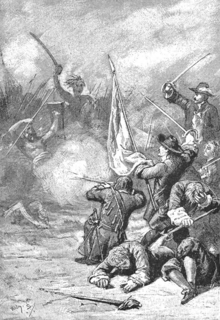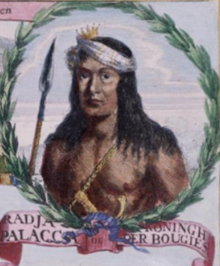Trunajaya rebellion
| Trunajaya rebellion | |||||||
|---|---|---|---|---|---|---|---|
 An 1890 Dutch depiction of fighting between VOC soldiers and Trunajaya's forces during the war | |||||||
| |||||||
| Belligerents | |||||||
|
|
Rebel forces Rival claimants to Mataram throne (after 1677) | ||||||
| Commanders and leaders | |||||||
|
|
Rebel leaders: Co-belligerent (1677–1681): | ||||||
| Strength | |||||||
|
|
Trunajaya: Puger: | ||||||
The Trunajaya Rebellion (also spelled Trunojoyo;
The uprising was initially successful; the rebels
After his father died in 1677, Amangkurat II also faced rival claims to the throne. The most serious rival was his brother
Background

Raden Trunajaya (also spelled Trunojoyo) was a descendant of the rulers of Madura, who was forced to live in the Mataram court after Madura's defeat and annexation by Mataram in 1624.[11] After his father was executed by Amangkurat I in 1656, he left the court, moved to Kajoran, and married the daughter of Raden Kajoran, the head of the ruling family there.[12][11] The Kajoran family was an ancient family of clerics and was related by marriage to the royal family.[12] Raden Kajoran was alarmed at the brutality of Amangkurat I's rule, including executions of noblemen at court.[11] In 1670 Kajoran introduced his son-in-law Trunajaya to the crown prince, who had recently been banished by the king due to a scandal, and the two forged a friendship that included a mutual dislike of Amangkurat.[11] In 1671 Trunajaya returned to Madura, where he used the crown prince's support to defeat the local governor and become the master of Madura.[13]
Makassar was the principal trading center east of Java.
Forces involved

Lacking a standing army, the bulk of Mataram's forces were drawn from troops raised by the king's vassals, who also provided the arms and supplies.[14][15] The majority of the men were peasants who were conscripted by the local lords (Javanese: sikep dalem).[15] In addition, the army included a small number of professional soldiers drawn from the palace guards.[14] The army used cannons, small firearms including flintlocks (Javanese: senapan, from Dutch snaphaens) and carbines, cavalry, and fortifications.[16] Historian M. C. Ricklefs said the transfer of European military technology to the Javanese was "virtually immediate", with the Javanese manufacturing gunpowder and firearms by 1620 at the latest.[15] Europeans were hired to train the Javanese troops in weapons handling, military leadership skills, and construction techniques,[15] but despite this training, the conscripted peasants of the Javanese armies often lacked discipline and fled during battle.[17][18] Mataram's troops numbered "much larger" than the rebel's 9,000 at Gegodog in September 1676,[1] dropped to just "a small retinue" after the fall of the capital in June 1677,[19] and grew to over 13,000 during the march to Trunajaya's capital at Kediri in late 1678.[2]
The VOC had professional soldiers of its own.[15] Each VOC soldier had a sword, small arms, cartridges, carrying pouches and belts, smoke bombs, and grenades.[15] The majority of VOC regulars were Indonesians, with a small number of European soldiers and marines, all under the command of European officers.[20] While in the technological sense, VOC troops were not superior to their indigenous counterparts,[16] they generally had better training, discipline, and equipment than indigenous Indonesian armies.[15] The VOC troops also differed about logistics: its troops marched in step followed by a long caravan of carts carrying supplies.[16] This gave them an advantage over Javanese troops, who often lived off the land and frequently faced supply shortages.[16] VOC forces numbered 1,500 in 1676,[21] but they were later augmented by Bugis allies under the leadership of Arung Palakka. The first contingent of 1,500 Bugis arrived in Java in late 1678,[5] and by 1679 there were 6,000 Bugis troops on Java.[6]
Similar to other belligerents, the armies of Trunajaya and his allies also used cannons, cavalry, and fortifications.[16] When the VOC took Surabaya from Trunajaya in May 1677, Trunajaya fled with twenty of his bronze cannons and left behind 69 iron and 34 bronze pieces.[22] Trunajaya's forces included Javanese, Madurese, and Makassarese.[1] When the rebels invaded Java in 1676, they numbered 9,000[1] and consisted of Trunajaya's followers and the Makassarese fighters. Later, the rebellion was joined by other Javanese and Madurese nobles. Notably, the lord of Giri, one of the most prominent Islamic spiritual lords in Java, joined in early 1676.[23] Trunajaya's father-in-law Raden Kajoran, head of the powerful Kajoran family, joined after Trunajaya's victory at Gegodog in September 1676,[24] and Trunajaya's uncle the prince of Sampang (later Cakraningrat II) joined after the fall of Mataram's capital in June 1677.[25]
Campaign
Beginning and initial rebel victories
The rebellion started with a series of raids from Makassarese pirates based in Demung against the trading towns on the northern coast of Java.
In September 1676, a rebel army of 9,000
VOC intervention and fall of Mataram's capital

In response to Mataram's request for intervention, VOC dispatched a large fleet containing Indonesian and European forces, commanded by Admiral Cornelis Speelman.[24] In April 1677 the fleet sailed to Surabaya, where Trunajaya was based.[24] After negotiations failed, Speelman's forces stormed Surabaya and took it after hard fighting.[30] The troops proceeded to clear the rebels from the area surrounding Surabaya.[30] VOC forces also took Madura, Trunajaya's native island, and laid his residence there in ruin.[31] Trunajaya fled Surabaya and established his capital in Kediri.[30]
Although the rebels were defeated in Surabaya, rebel forces campaigning in the interior of Central and East Java had more success. The rebel campaign culminated in the fall of the capital Plered in June 1677.[31] The king was ill, and distrust among the royal princes prevented organized resistance.[31] The king fled west with the crown prince and his retinue, allowing the rebels to enter and plunder the capital with little fighting.[31] The rebels then withdrew to Kediri, taking the royal treasury with them.[32]
Amangkurat II's accession and alliance with the VOC
King Amangkurat I died during his retreat in
Having no army or treasury and unable to assert his authority, Amangkurat decided to ally himself with the VOC.
VOC–Mataram forces made slow progress against the rebels.
Loyalist victories and the death of Trunajaya

VOC and Mataram forces
After the fall of his stronghold in Kediri, Trunajaya managed to escape to the mountains of eastern Java.
End of Pangeran Puger's rebellion
In addition to Trunajaya's forces, Amangkurat II continued to face opposition from his brother Pangeran Puger, who had taken the old capital in Plered and had claimed the throne for himself in 1677.[33] Before the defeat of Trunajaya, Amangkurat's forces had not taken action against him.[34] After Trunajaya was defeated, Amangkurat still could not convince his brother to submit.[7] In September 1680 Amangkurat constructed a new capital in Kartasura.[7] In November, Amangkurat and VOC forces drove Puger from Plered.[7] However, Puger quickly rebuilt his forces, took Plered again in August 1681, and nearly took Kartasura.[7] In November 1681 VOC and Mataram forces again defeated Puger, and this time he submitted and was pardoned by his brother.[7][44]
Aftermath

Amangkurat II secured his reign with the defeat of the rebels. Due to the rebel capture and subsequent destruction of the capital in Plered, he built a new capital, Kartasura, in the district of Pajang, and moved his court there.
The king's brother Pangeran Puger, who tried to claim the throne during the Trunajaya rebellion, was pardoned by the king.
References
Footnotes
- ^ a b c d e f Andaya 1981, pp. 214–215.
- ^ a b Ricklefs 1993, p. 50.
- ^ Ricklefs 1993, p. 35.
- ^ a b Ricklefs 1993, p. 51.
- ^ a b Andaya 1981, p. 218.
- ^ a b Andaya 1981, p. 221.
- ^ a b c d e f g h i j k l Ricklefs 2008, p. 94.
- ^ Pigeaud 1976, pp. 56–57.
- ^ a b Pigeaud 1976, p. 55.
- ^ a b c d Pigeaud 1976, p. 66.
- ^ a b c d Pigeaud 1976, p. 67.
- ^ a b c Ricklefs 2008, p. 90.
- ^ a b c d e f Pigeaud 1976, p. 68.
- ^ a b Houben & Kolff 1988, p. 183.
- ^ a b c d e f g Taylor 2012, p. 49.
- ^ a b c d e Houben & Kolff 1988, p. 184.
- ^ Houben & Kolff 1988, pp. 183–184.
- ^ Taylor 2012, pp. 49–50.
- ^ Pigeaud 1976, p. 74.
- ^ a b c Pigeaud 1976, p. 79.
- ^ a b c Ricklefs 2008, p. 92.
- ^ Ricklefs 1993, p. 39.
- ^ Ricklefs 1993, p. 40.
- ^ a b c d e Pigeaud 1976, p. 71.
- ^ Ricklefs 1993, p. 41.
- ^ a b c d e Pigeaud 1976, p. 69.
- ^ Pigeaud 1976, pp. 69–70.
- ^ a b c d e f g h i Pigeaud 1976, p. 70.
- ^ Andaya 1981, pp. 215.
- ^ a b c Pigeaud 1976, p. 72.
- ^ a b c d e Pigeaud 1976, p. 73.
- ^ a b c d e f Ricklefs 2008, p. 93.
- ^ a b c d e Pigeaud 1976, p. 76.
- ^ a b c d e f g Pigeaud 1976, p. 77.
- ^ Pigeaud 1976, pp. 76–77.
- ^ Pigeaud 1976, p. 78-79.
- ^ Pigeaud 1976, p. 80.
- ^ a b Pigeaud 1976, p. 89.
- ^ a b Pigeaud 1976, p. 82.
- ^ a b c Pigeaud 1976, p. 83.
- ^ Ricklefs 1993, p. 57.
- ^ Pigeaud 1976, p. 84.
- ^ Pigeaud 1976, pp. 83–84.
- ^ a b c d Pigeaud 1976, p. 94.
- ^ a b c Ricklefs 2008, p. 95.
- ^ a b Ricklefs 2008, p. 99.
- ^ a b Pigeaud 1976, p. 95.
- ^ Ricklefs 2008, p. 100.
- ^ a b Ricklefs 2008, p. 101.
- ^ a b c Pigeaud 1976, p. 103.
Bibliography
- ISBN 978-9004287228.
- Houben, V.J.H; Kolff, D.H.A. (1988). "Between Empire Building and State Formation. Official Elites in Java and Mughal India". Itinerario. 12 (1): 165–194. S2CID 161993016.
- ISBN 90-247-1876-7.
- ISBN 978-1-86373-380-9.
- Ricklefs, M.C. (2008). A History of Modern Indonesia Since c. 1200. ISBN 978-1-137-05201-8.
- Taylor, Jean Gelman (2012). Global Indonesia. Routledge. ISBN 978-0-415-95306-1.
